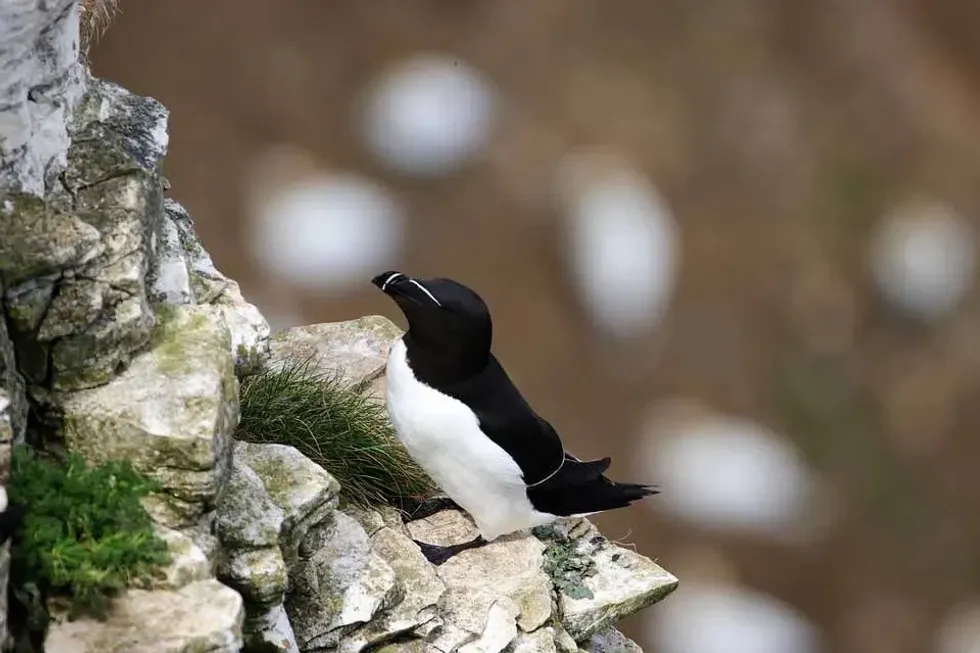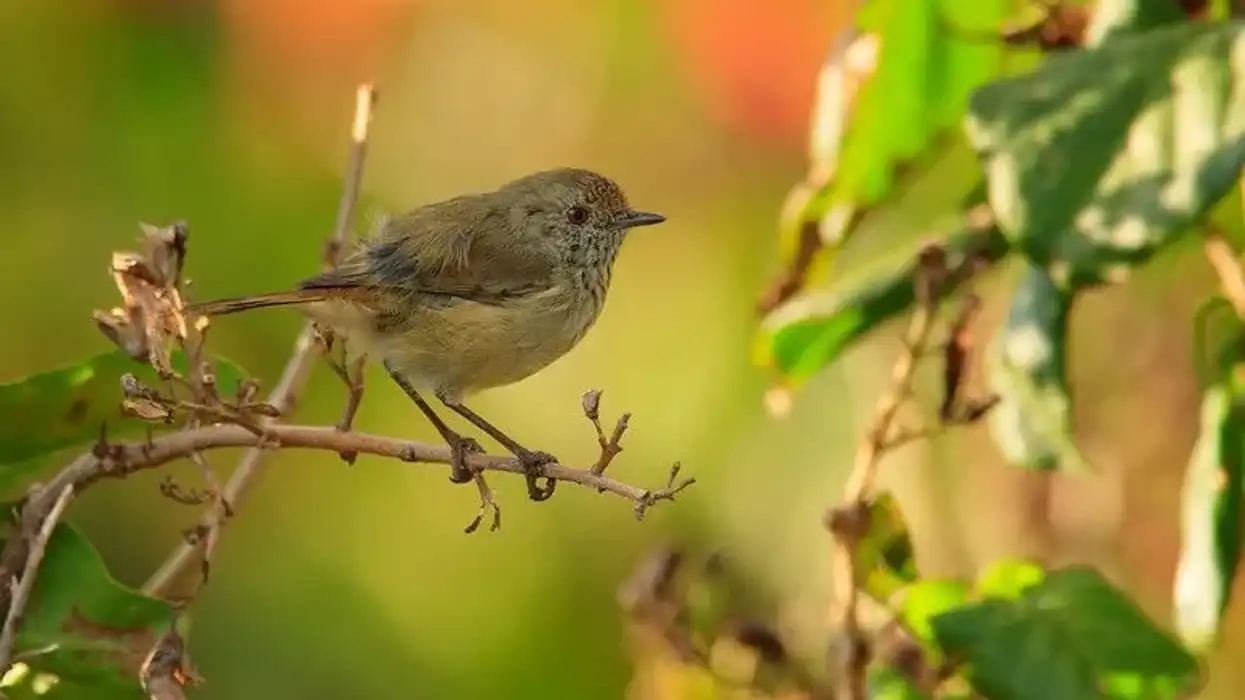The razorbill (Alca torda) is of the order Charadriiformes and the family Alcidae. They are collectively referred to as auks. They are also commonly known as razor-billed auks or lesser auks.
Razorbill birds are coastal birds and they are distributed throughout the subarctic and boreal waters of the northern Atlantic Ocean. More than half of the present pairs making up the global razorbill population are found in Iceland!
These birds show a different breeding range and migratory range and as a result, are found inhabiting different regions in different seasons. They fly from the north to the south when they migrate and razorbill pairs move to offshore colonies during the breeding season.
These birds form monogamous pairs and stay together for the rest of their life. Each adult pair also comes back to the same nest year after year.
Currently, these birds are facing struggles to survive due to climate change and the fluctuating marine population which serves as their food. To find out more about this wonderful bird, why not go through these fascinating details about the razorbill penguin? For similar content check out our guide to the marbled murrelet and the black-necked stilt too.
Razorbill Interesting Facts
What type of animal is a razorbill?
The razorbill (Alca torda) is a type of medium-sized seabird that is found in the northern part of the subarctic Atlantic Ocean.
What class of animal does the razorbill belong to?
The razorbill belongs to the class Aves which is the common class for all birds.
How many razorbills are there in the world?
The population of razorbill birds is decreasing quickly in Europe except Scotland. In Iceland, which holds 60% of the global population of these birds, the population has declined by 25-26% in recent years. However, their population is stable in North America. There are around 979,000-1,020,000 birds found in Europe and the world population is below 1,000,000 breeding pairs.
Where does Razorbill live?
The breeding range of razorbills extends from west of Greenland to as far south as Maine in North America. Their breeding population can also be found in Western Europe from the northwest of France to Russia.
In the winter season, migratory North American species fly from the coastal areas of Grand Banks and the Labrador Sea in Newfoundland, Canada, and settle in colonies to the south. These North American birds generally spend winter in New England, New Jersey, or off the coast of New Hampshire.
Some Eurasian species migrate to the south to the Mediterranean coast of North Africa in the winter.
Large colonies of resident and migratory species are found even in Scotland. While many razorbills of Scotland breed in their colonies, some fly to the English Channel or the Atlantic coast too.
What is a razorbill's habitat?
Razorbills are found in the open sea or the offshore water of islands. Breeding colonies of the bird are found on islands, on coastal cliffs, and cliffs and ledges under boulders.
Razorbill nest colonies are found in the rocky sea cliffs of islands and the mainland. They are not deep divers and forage in shallow and colder water so they prey mainly on nearshore wildlife.
The razorbill auk is a species of seabird that only come out of water for breeding purposes. The bird also travels over water, covering large areas, in winter for migration.
Who do razorbills live with?
Razorbill is a monogamous bird and lives in its breeding pair for life. They forage for food in flocks but they remain scattered in these flocks.
Before eggs are laid, socialization peaks in these birds and they can be seen swimming in circles or lines in flocks. These birds are friendly to other birds of the same species as well as to other species. They communicate with each other when they come offshore in the breeding season.
How long does the razorbill live?
The average lifespan of razorbill birds is 13 years. However, it is believed that in the United Kingdom, one bird of this species lived a long life of 41 years!
How do they reproduce?
Mating between adult pairs occurs more than once each breeding season to display affection. Breeding in razorbills takes place between individuals aged three to five years old.
The razorbill call for courtship includes growls. They make these sounds by raising their head, pointing their bill upwards, and then bowing down.
Other courtship displays include touching each other's bills and following each other while in flight. The female bird lays one egg per breeding season and her male partner guards her, protecting her from other males until she lays the egg. The razorbill egg hatches around 35 days later and the young stay under their parents' wings to stay warm.
Both parents take turns incubating the egg and they share responsibility for the young bird. After 17-23 days the male parent leads the young out of the nest into the sea for the first time.
What is their conservation status?
The IUCN Red List has listed the razorbill as a species that faces threats and their population has become vulnerable. They are a Near Threatened species in the IUCN Red List and the most major threat is the destruction of their habitat.
Razorbill Fun Facts
What do razorbills look like?
The razorbill (Alca torda) is often confused with another member of the auk family called guillemots. Guillemots share a skin pattern and color similar to the razorbill.
The razorbill is a duck-sized bird with black upperparts and a long stretched white belly. The razorbill winter plumage is not much different from its summer plumage, except for the white line that extends from their eyes to their beak that is absent during the razorbill winter plumage.
Their thick blunt bill acts as an identifying characteristic of these birds. It is jet black and looks a bit compressed from the end. The tip of the bill also has many curved grooves and furrows.
In their breeding plumage, the feathers of their head and their beak look darker than in their non-breeding plumage. They have a distinctly long and pointed tail and webbed feet.

How cute are they?
Razorbills look similar to penguins in many aspects. They form an adorable flock of birds that do not mean any harm to mankind!
How do they communicate?
This bird communicates mainly by using vocalizations. The use of their body language also plays an important role in razorbill behavior and communication. A loud growling sound acts as the bird's mating call.
How big is a razorbill?
A razorbill male and female are more or less the same in size but they have very slight differences in their wingspan when in flight. The length of these birds ranges from 14.6-15.4 in (37–39 cm).
The wingspan of an adult male razorbill in flight ranges from 7.9–8.5 (201-216 mm) and for a female, it is between 7.9-8.4 in (201-213 mm). They are smaller in size than their extinct relatives, the great auk.
How fast can a razorbill fly?
They are typically not fast fliers. A razorbill flying during the breeding season can attain a maximum speed of 3 mph (5 kph).
How much does a razorbill weigh?
The weight of these duck-sized birds is 17.8-31.4 oz (505-890 g).
What are the male and female names of the species?
Male and female razorbill birds do not have any particular names. Both genders of the species are together called razorbills.
What would you call a baby razorbill?
A baby bird is called a chick or nestling. Similarly, a razorbill baby is also known as a chick or nestling.
What do they eat?
They are predator birds who kill and eat aquatic animals underwater by diving to a shallow depth, holding their breath for up to one minute. The most common foods that are included in this bird's diet are schooling fish like capelin, herring, and sprat. Sometimes they also feed on crustaceans, squid, marine worms, and shrimp.
Are they aggressive?
Razorbill is not an aggressive bird species. However, in their nests, they are less likely to get into aggressive fights with other birds and if their partners are chased by another bird, they will protect them.
Would they make a good pet?
Whilst these are amazing birds, they must be left in their natural habitat, so keeping them as pets is not advised.
Did you know...
The Razorbill is the only living member of the genus Alca and is the closest living relative of the extinct great auk.
Are razorbills, guillemots, and puffins in competition?
Although all three birds' diets comprise fish as the primary food, they do not compete because of the different sizes of their prey. Guillemots aim for large fish, whilst puffins aim for small fish, and the razorbill mainly preys on mid-sized schooling fish.
Where do razorbills make their nests?
The razorbill species do not tend to make their nests. At best, they drag pebbles and grass with their beak, onto which they lay an egg.
The birds usually inhabit rocky ledges, crevices under boulders, and sometimes nests formed by other animals like puffins or burrows of rabbits. They prefer locations where their young will be protected from their common predators.
Unlike other shorebirds of the auk family, these birds do not form their nests immediately alongside the ocean. They nest 3 in (10 cm) away from the sea as beyond this range, it becomes difficult for young individuals to access the water (as they cannot fly when they are juvenile).
Here at Kidadl, we have carefully created lots of interesting family-friendly animal facts for everyone to discover! Learn more about some other birds including the puffin or the killdeer.
You can even occupy yourself at home by drawing one on our Razorbill coloring pages.










